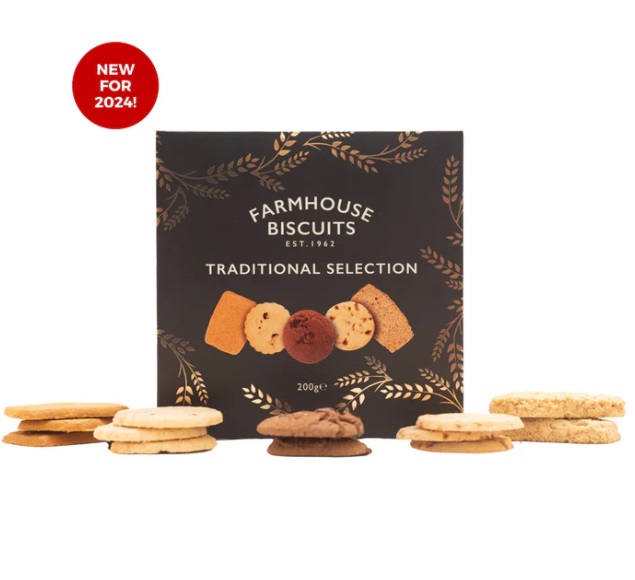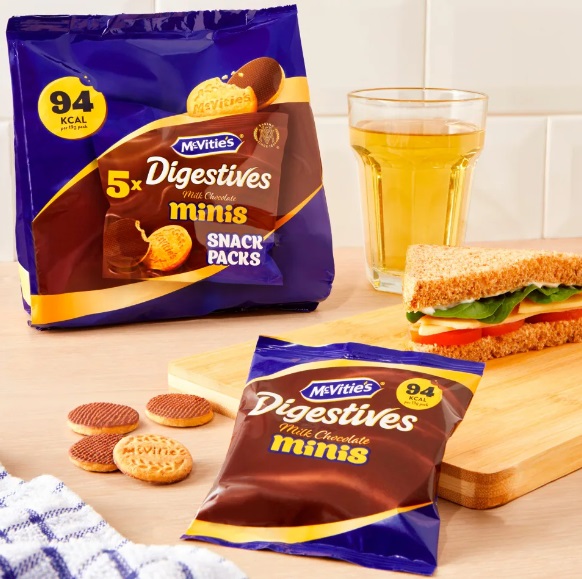
Why Farmhouse Black Traditional Selection Box is a Must-Have for Biscuit Lovers
There’s something undeniably comforting about the timeless simplicity of biscuits. For those who cherish the delicate crunch, the rich flavors,
Few treats evoke the cozy charm of British teatime quite like the humble ginger biscuit. crisp, aromatic, and subtly spiced, these golden discs have been a staple of the nation’s cupboards for centuries, carrying with them whispers of history and tradition. Beyond thier comforting crunch, ginger biscuits tell a richer story—one that intertwines colonial trade routes, domestic rituals, and the evolving artistry of baking.As we embark on this exploration, we’ll journey through time to uncover how these unassuming delights carved a special place in British culture, becoming more than just a sweet indulgence, but a symbol of heritage and heartwarming connection.
Ginger biscuits, known for their warm and spiced aroma, have a history that traces back to ancient trade routes, where spice-laden ships carried treasures from distant lands. Ginger, revered for its medicinal and culinary properties, made its way to europe through the silk and spice trades.By the medieval period, biscuits infused with ginger became favored treats, cherished for their ability to balance sweetness with a peppery zing. Bakers began experimenting with ginger in baked goods, crafting small, durable biscuits that could endure long journeys—perfect for explorers and merchants alike.
One fascinating aspect of ginger biscuits is their evolution in readiness.Early recipes frequently enough relied on molasses or treacle to create dense, richly flavored doughs, while spices like cloves and nutmeg complemented the ginger. Over centuries, these biscuits transformed from utilitarian traveler’s fare to a celebrated staple of British teatime traditions. Below is a comparison of ingredients used in ginger biscuits over time:
| Era | Main Ingredients |
|---|---|
| Medieval | ground ginger, honey, flour |
| Victorian | Molasses, spices, butter |
| Modern | Sugar, golden syrup, ginger |
At the heart of family kitchens across Britain lies a treasure trove of cherished traditions, where ginger biscuits often serve as a sweet link between generations. These spiced delights have been passed down, not just as recipes, but as heirlooms of memories and shared moments. grandmothers once scribbled their secret tips in notebooks, creating variations that mirrored local flavors or seasonal ingredients.The subtle art of balancing ginger’s fiery warmth with a perfect crunch turns every batch into a unique expression of familial love and creativity.
The beauty of these handed-down recipes frequently enough lies in their simplicity and adaptability,reflecting the personal touch of each baker in the lineage. Here are some traits that make traditional ginger biscuits so enduring:
| Legacy Element | Passed Down Trait |
|---|---|
| Recipe Adjustments | Custom spice blends hidden within families. |
| Baking Tools | Hand-me-down rolling pins and cookie cutters. |
| Storytelling | Anecdotes shared while baking together. |
Ginger biscuits hold a special place in the tapestry of British festivities, carrying with them centuries of tradition and warmth. From lavish holiday feasts to modest family gatherings, these spiced delights are imbued with a sense of nostalgia and party. During Christmas, they are often intricately decorated, transforming into edible art as gingerbread shapes like stars, hearts, and even entire houses take center stage. the peppery sweetness balanced with a hint of cinnamon and clove feels like the very essence of the festive season. Beyond Christmas, ginger biscuits are also a staple at events like Bonfire Night, where they pair perfectly with cups of mulled cider or steaming hot chocolate under fireworks-lit skies.
Integral to these customs is the act of gifting and sharing ginger biscuits, symbolizing warmth and community.Families frequently enough bake them together, passing down treasured recipes that vary slightly in spice levels or texture, creating a sense of identity for each lineage. Traditional pairings and their significance also elevate the ritual:
| Pairing | Symbolism |
|---|---|
| Mulled Wine | Warmth and Celebration |
| Hot Chocolate | Cozy Comfort |
| Cheddar Cheese | Sweet-Savory Harmony |
These small gestures, paired with the aromatic charm of ginger biscuits, continue to make them a cherished element of British holiday traditions, bridging generations through taste and a shared love for cozy festivities.
Across Britain’s picturesque landscapes, generations of bakers have turned traditional kitchens into cherished landmarks. These bakeries, steeped in local lore, have not only shaped the ginger biscuit’s heritage but have also given life to a variety of regional interpretations. From Yorkshire’s hearty spiced snaps to Cornwall’s delicately sweetened rounds, the diversity of ginger treats mirrors the county-by-county pride found in British baking traditions. Today,many of these historic bakeries share their secrets in storefronts adorned with rustic charm,enticing visitors with aromas that speak of centuries-old recipes.
The magic, though, isn’t confined to just the bakeries. ginger biscuits have evolved into cultural icons, gracing afternoon tea tables, holiday celebrations, and festive markets across the UK. Whether paired with warming cider during Christmas markets or enjoyed plain with bold British tea, they embody a timeless ritual of indulgence. Iconic ginger treats like gingerbread men or ginger parkin create seasonal excitement while their simpler cousins—crispy ginger biscuits—settle comfortably as everyday favorites. Below is a brief comparison of two famed ginger delights:
| Ginger Treat | texture | Occasion |
|---|---|---|
| Gingerbread Men | Soft & Decorated | Festive Holidays |
| Crispy Ginger Biscuits | Crisp & crunchy | Everyday Tea Time |
The dance between spices and sweetness in ginger biscuits is a testament to centuries of refinement and culinary intuition. Ginger, with its warm and slightly peppery notes, offers a rich, aromatic canvas that demands respect.On this foundation, bakers have traditionally incorporated honey, brown sugar, or molasses to weave layers of sweetness that balance the pungency of the spice. This harmonious duet has allowed the biscuit to evolve into a timeless delicacy — indulgent yet never overwhelming. The mastery lies in achieving perfect equilibrium,ensuring neither the spice nor the sweetness triumphs,but rather they exist in poetic synchronization.
British bakers have perfected this pairing over generations by introducing complementary flavors and textures to elevate the treat. Some common enhancements include:
The chart below showcases how key ingredients contribute to the balance in traditional recipes:
| Ingredient | Role in Flavor |
|---|---|
| Ginger | Spicy aroma and warmth |
| Brown Sugar | Deep caramel sweetness |
| Molasses | Rich texture and bittersweet notes |
| Cinnamon | Mellow spice for balance |
bringing the essence of authentic ginger biscuits back into modern kitchens is a delightful journey. Start by sourcing high-quality ingredients like fresh ground ginger and rich molasses to replicate their traditional flavor. Opt for unbleached flour and natural sweeteners to ensure a true homage to historical recipes. If you prefer a lighter texture, experiment with a combination of plain and wholemeal flours for added depth. To enhance the fragrance,consider adding a pinch of nutmeg or a splash of orange zest—secret touches that some vintage bakers swore by.
| Tip | Benefit |
|---|---|
| Sprinkle sugar before baking | Creates a caramelized crunch |
| bake at a lower temperature | Achieves a chewier texture |
Exploring the Rich History of Ginger Biscuits in British culture
Q1: How did ginger first make its way into British baking traditions?
A1: Ginger arrived in Britain during the medieval period, brought back by Crusaders and traders journeying through the spice routes. Its exotic warmth quickly earned it a prized place in kitchen cupboards, especially among bakers eager to experiment with spiced confections. Over time, it became an essential ingredient for biscuits and baked goods, blending seamlessly into Britain’s culinary identity.
Q2: Why were ginger biscuits particularly popular during the Victorian era?
A2: Ginger biscuits rose to prominence in the Victorian era due to their versatility and long shelf life. Affordable and easy to make, they became a staple in households and tea rooms alike. Victorians also believed in ginger’s medicinal properties, using these biscuits to ward off ailments and chills, which only added to their widespread popularity.
Q3: What role do ginger biscuits play in British celebrations and traditions?
A3: Ginger biscuits are often tied to festive occasions, particularly Christmas. The warming spice evokes a sense of comfort and nostalgia during colder months, and many families pass down heirloom recipes for this quintessential treat.From gingerbread men to intricately spiced biscuits, they remain a staple of celebratory feasts and teatime rituals.Q4: How have ginger biscuits evolved over the centuries?
A4: While the basic recipe of ginger biscuits has remained true to its roots, modern adaptations have seen creative twists. From dipped chocolate varieties to vegan and gluten-free versions, today’s ginger biscuits cater to a wide range of tastes and dietary preferences. Though, the classic crisp snap and spicy-sweet flavor remain unchanged, continuing to charm across generations.
Q5: What makes ginger biscuits a symbol of British culture?
A5: Ginger biscuits symbolize Britain’s ability to blend tradition with innovation. They reflect the nation’s love of tea and the art of teatime, often paired with a cuppa for a moment of indulgence.Above all, their enduring popularity speaks to the way simple flavors can bridge history and offer comfort, making ginger biscuits a timeless classic in british culture.
As we crumble into the final morsel of this journey through the rich history of ginger biscuits in British culture, it’s clear that these spiced delights are more than just a teatime treat—they’re a symbol of tradition, resilience, and a little spark of sweetness passed down through generations. Whether dunked in a steaming cup of tea or savored on frosty evenings by the fire, ginger biscuits continue to carry whispers of the past while remaining warmly nestled in the present. So, the next time you bite into that golden, spiced biscuit, pause for a moment and remember—you’re not just enjoying a simple snack; you’re savoring a legacy that has traveled centuries, fragrant with warmth, history, and timeless British charm.

There’s something undeniably comforting about the timeless simplicity of biscuits. For those who cherish the delicate crunch, the rich flavors,

The sweetest Evolution: Tracing the Journey of Digestive Biscuits Few snacks boast a legacy as enduring and charming as
© Zam Prime Store 2025